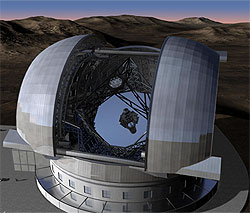Thanks to the world’s most successful optical observatory, European Southern Observatory’s (ESO) Very Large Telescope, and the cutting-edge facilities in radio astronomy and in space, Europe has emerged as a global leader in astronomy.
In an effort to demonstrate the potential of European scientific cooperation, all of European astronomy is now joining forces to define the scientific challenges for the future. The Astronet network, a bold new plan supported by the European Commission and coordinated by the CNRS, has presented a roadmap for the future, ranking the ESO’s Extremely Large Telescope as one of two top-priority large ground-based projects.

Top view of the 3-dimensional model of the European Extremely Large Telescope and its enclosure. The primary mirror has a diameter of 42 m and is composed of 906 segments, each 1.45 m wide. The secondary mirror is as large as 6 m in diameter. Image courtesy of the ESO.
In 2007, a top-level Science Vision was prepared to assess the most pressing scientific questions over the next quarter century, ranging from dark energy to life on other planets. European astronomy now presents its Infrastructure Roadmap, a comprehensive 20-year plan to coordinate national and community investments to meet these challenges in a cost-effective manner. The Roadmap not only prioritises the necessary new frontline research facilities from radio telescopes to planetary probes, in space and on the ground, but also considers such key issues as existing facilities, human resources, ICT infrastructure, education and outreach, and cost of operations as well as construction.
To build consensus on priorities in a very diverse community, the Science Vision and Roadmap were developed in an open process involving intensive interaction with the community through large open meetings and feedback via e-mail and the web. The result is a plan now backed by astronomers in 28 Member and Associated States of the EU, with over 500 million inhabitants.
Over 60 selected experts from across Europe contributed to the construction of the Astronet Roadmap, ensuring that European astronomy has the tools to compete successfully in answering the challenges of the Science Vision. They identified and prioritised a set of new facilities to observe the Universe from radio waves to gamma rays, to open up new ways of probing the cosmos, such as gravitational waves, and to advance in the exploration of our Solar System. In the process, they considered all the elements needed by a successful scientific enterprise, from global-scale cooperation on the largest mega-project to the need for training and recruiting skilled young scientists and engineers.
Among the large ground-based projects is the ESO’s European Extremely Large Telescope (E-ELT), which has a 42-meter diameter mirror that makes the E-ELT the largest optical, near infrared telescope in the world. Dubbed "the biggest eye in the sky," this telescope studies exoplanets and discs, galaxy formation and dark energy.
"The top ranking of the E-ELT in the Roadmap is a strong endorsement from the European astronomical community." Says Tim de Zeeuw, ESO director general. "This flagship project will indisputably raise the European scientific, technological and industrial profile."
The Roadmap also identifies a need for better access to state-of-the art computing and laboratory facilities, and for a stronger involvement of European high-tech industry in the development of future facilities. Moreover, success depends critically upon an adequate supply of qualified scientists, and of engineers in fields ranging from IT to optics. Finally, the Roadmap proposes a series of measures to enhance the public understanding of astronomy as a means to boost recruitment in science and technology in schools and universities across Europe.
Europe currently spends approximately $2.6 billion a year on astronomy in the broadest sense. Implementing the Astronet Roadmap will require a funding increase of around 20 percent. Global cooperation will be needed, and is being planned, for several of the largest projects.
Some top-priority projects from the full list include:
Among large-scale projects on the ground:
• The European Extremely Large Telescope, by far the largest optical telescope ever to be built, with a 42 m segmented mirror to study the sky in visible and infrared light.
• The Square Kilometre Array, a vast radio telescope occupying large parts of a continent. The SKA is being planned by a worldwide consortium.
Scientifically compelling instruments in a lower cost range include:
• A 4 m European Solar Telescope, to be based in the Canary Islands.
• An array of specialised optical telescopes to detect gamma-ray emission from black holes and other high energy events across the Universe.
• An underwater telescope to detect neutrinos — sub-atomic particles that can pass through the entire Earth and bring information on some of the most violent phenomena in the Universe.
Among the largest space missions proposed for the coming decade, the top priorities for Astronet include:
• A mission to study gravitational waves from the Big Bang and black holes in the Universe.
• An X-ray mission to study galaxies, galaxy clusters, and stars in unprecedented detail.
• Two proposed missions to study the planets Jupiter and Saturn and their satellites.
Equally challenging, but less costly top-priority space projects include:
• A mission designed to unlock the secrets of dark energy and dark matter.
• A mission to understand the workings of our own star, the Sun, in greater detail than ever before.
For more information, visit: www.eso.org